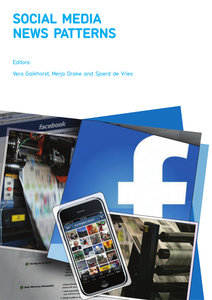We present an evaluation of tools for assessing the impact of AI in the Dutch media sector. Our evaluation of the ECP AIIA tool shows the need for clear guidelines in the adoption of various AI applications within Dutch media organisations. We conclude that the adoption of impact assessment tools, such as the ECP AIIA, is not held back by common media practice, but rather by commercial considerations.
DOCUMENT
In this paper we discuss the general approach and choices we made in developing a prototype of a social media monitor. The main goal of the museum monitor is to offer museum professionals and researchers better insight in the effects of their own social media usage and compare this with other actors in the cultural heritage sector. It gives researchers the opportunity to consider communication within the sector as whole. In the research project “Museum Compass” we have developed a prototype of a social media monitor, which contains data of current and historic online activities on Facebook, Twitter, YouTube, Foursquare and Flickr of all registered Dutch museums. We discuss – mostly in a practical sense – our approach for developing the monitor and give a few examples as a result of its usage.
DOCUMENT

Wereldwijd onderzoek: Hoe gebruiken nieuwsmedia social media? Jongeren lezen geen krant meer, ze kijken op hun smartphone die ze altijd bij de hand hebben. Binnen het lectoraat social media en reputatiemanagement van NHL hogeschool te Leeuwarden heeft een groep internationale studenten in 12 landen onderzoek gedaan. Hierbij hebben ze meer dan 150 social media sites bestudeerd van nieuws media. De resultaten maken deel uit van een internationaal onderzoek van NHL Hogeschool en Haaga Helia University. De onderzoeksvraag was: Wat speelt zich af in de nieuwsmedia? Persbureaus kunnen het overzicht gebruiken om hun social media te optimaliseren. En voor ieder die journalistiek een warm hart toedraagt is het interessante informatie over de nieuwsmedia in een overgangssituatie (2nd edition)
DOCUMENT

In dit whitepaper vindt u de resultaten van onze jaarlijkse social media MKB-monitor. Met deze monitor doen we onderzoek naar het gebruik van sociale media in het MKB. In dit whitepaper vindt u de resultaten van de monitor en kansen voor de toekomst
DOCUMENT

Whitepaper: The use of AI is on the rise in the financial sector. Utilizing machine learning algorithms to make decisions and predictions based on the available data can be highly valuable. AI offers benefits to both financial service providers and its customers by improving service and reducing costs. Examples of AI use cases in the financial sector are: identity verification in client onboarding, transaction data analysis, fraud detection in claims management, anti-money laundering monitoring, price differentiation in car insurance, automated analysis of legal documents, and the processing of loan applications.
DOCUMENT

De publieke sector is in digitale transformatie en biedt haar diensten in toenemende mate digitaal. Tegelijkertijd hebben publieke dienstverleners te maken met de uitdaging om de dienstverlening 'persoonlijk' bij individuele burgers aan te laten sluiten. Hogeschool Utrecht deed de afgelopen twee jaar samen met Belastingdienst, Vitens, RET en een aantal andere publieke organisaties onderzoek naar hoe die twee zaken te combineren. In deze whitepaper bieden wij op basis van een groeimodel vier aanbevelingen die publieke organisaties helpen hun dienstverlening succesvol te digitaliseren en tegelijk persoonlijk te laten aansluiten bij hun burgers.
LINK
full text via link. Wat zijn de ontwikkelingen in social media research, naar wie luisteren we nu eigenlijk in social media, wie is de werkelijke innovator en wie is de werkelijke deler, en wat kunnen merken met klantervaringen? Anita Cox (Insights Director) trapt af met de vraag: Waarom zagen we social media 5 jaar geleden niet aankomen? -
LINK
The online presence of organizations is long gone from being just a web page. Social media have enabled easy and inexpensive interaction between millions of individuals and communities. This has not gone unnoticed by cultural heritage institutes. The question is what all these social media activities bring. Even if an institute knows what it tries to achieve online, the metrics often consist of confusing accumulation of statistics, across several systems and reveal little about online user behaviour, engagement and satisfaction. In the research project Museum Compass a prototype of a social media monitor is developed, which will contain data of current and historic online activities on Facebook, Twitter, YouTube, Foursquare and Flickr of all registered Dutch museums. The first version of this monitor has been developed, and we believe that this is a good moment to discuss – mostly in a practical sense – our general approach and preliminary results.
DOCUMENT

This white paper is the result of a research project by Hogeschool Utrecht, Floryn, Researchable, and De Volksbank in the period November 2021-November 2022. The research project was a KIEM project1 granted by the Taskforce for Applied Research SIA. The goal of the research project was to identify the aspects that play a role in the implementation of the explainability of artificial intelligence (AI) systems in the Dutch financial sector. In this white paper, we present a checklist of the aspects that we derived from this research. The checklist contains checkpoints and related questions that need consideration to make explainability-related choices in different stages of the AI lifecycle. The goal of the checklist is to give designers and developers of AI systems a tool to ensure the AI system will give proper and meaningful explanations to each stakeholder.
MULTIFILE
